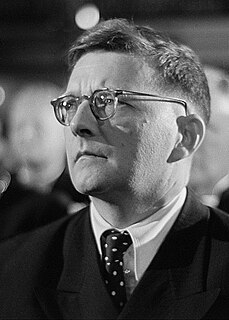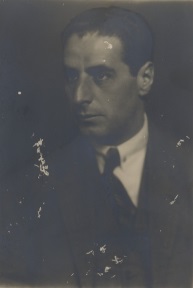
The 24 Preludes, Op.34, is a set of short piano pieces written and premiered by Dmitri Shostakovich in 1933. They are arranged following the circle of fifths, with one prelude in each major and minor key.

The 24 Preludes, Op.34, is a set of short piano pieces written and premiered by Dmitri Shostakovich in 1933. They are arranged following the circle of fifths, with one prelude in each major and minor key.
Shostakovich began composing the preludes in December 1932, shortly after finishing composition of the opera Lady Macbeth of the Mtsensk District . He completed the cycle in March 1933, and premiered it in Moscow himself in May of the same year. [1] He composed the preludes largely in order to return to public performance. [2] He had stopped performing in 1930, after his failure to place at the 1927 First International Chopin Piano Competition. [3] The Preludes were first published by Muzgiz in 1935, two years after their premiere. [1]
In the 1930s, violinist Dmitri Zyganov transcribed 19 of the preludes for violin and piano. Shostakovich stated, "When I hear the transcriptions, I forget meanwhile that I actually composed the Preludes for piano. They sound so violinistic." [4] In 2000, composer and pianist Lera Auerbach made an arrangement of the remaining five preludes.

Dmitri Dmitriyevich Shostakovich was a Soviet and Russian composer and pianist. He is regarded as one of the major composers of the 20th century, with a unique harmonic language and a historic importance due to his years of work under Stalin.

Sergei Sergeyevich Prokofiev was a Russian Soviet composer, pianist and conductor. As the creator of acknowledged masterpieces across numerous music genres, he is regarded as one of the major composers of the 20th century. His works include such widely heard pieces as the March from The Love for Three Oranges, the suite Lieutenant Kijé, the ballet Romeo and Juliet—from which "Dance of the Knights" is taken—and Peter and the Wolf. Of the established forms and genres in which he worked, he created – excluding juvenilia – seven completed operas, seven symphonies, eight ballets, five piano concertos, two violin concertos, a cello concerto, a symphony-concerto for cello and orchestra, and nine completed piano sonatas.
A prelude is a short piece of music, the form of which may vary from piece to piece. The prelude may be thought of as a preface. While, during the Baroque era, for example, it may have served as an introduction to succeeding movements of a work that were usually longer and more complex, it may also have been a stand-alone piece of work during the Romantic era. It generally features a small number of rhythmic and melodic motifs that recur through the piece. Stylistically, the prelude is improvisatory in nature. The prelude also may refer to an overture, particularly to those seen in an opera or an oratorio.

Tatyana Petrovna Nikolayeva was a pianist, composer and teacher from Soviet Russia.
24 Preludes and Fugues, Op. 87 by Dmitri Shostakovich is a set of 24 preludes and fugues for solo piano, one in each of the major and minor keys of the chromatic scale. The cycle was composed in 1950 and 1951 while Shostakovich was in Moscow and premiered by pianist Tatiana Nikolayeva in Leningrad in December 1952; it was published the same year. The complete work takes about two and a half hours to play. It is one of several examples of music written in all major and/or minor keys.
Dmitri Shostakovich composed his Symphony No. 4 in C minor, Opus 43, between September 1935 and May 1936, after abandoning some preliminary sketch material. In January 1936, halfway through this period, Pravda—under direct orders from Joseph Stalin—published an editorial "Muddle Instead of Music" that denounced the composer and targeted his opera Lady Macbeth of Mtsensk. Despite this attack, and despite the oppressive political climate of the time, Shostakovich completed the symphony and planned its premiere for December 1936 in Leningrad. After rehearsals began, the orchestra's management cancelled the performance, offering a statement that Shostakovich had withdrawn the work. He may have agreed to withdraw it to relieve orchestra officials of responsibility. The symphony was premiered on 30 December 1961 by the Moscow Philharmonic Orchestra led by Kirill Kondrashin.

Ernst Toch was an Austrian composer of classical music and film scores. He sought throughout his life to introduce new approaches to music.
The String Quartet No. 15 in E-flat minor, Op. 144 by Dmitri Shostakovich is the composer's last. It was his first quartet since the Sixth and only one of three which did not bear a dedication.

Mieczysław Weinberg was a Polish-born Soviet composer. Ever since a revival concert series in the 2010 Bregenz Festival in Austria, his music has been increasingly described as "some of the most individual and compelling music of the twentieth century". Weinberg's output was extensive, encompassing 26 symphonies, 17 string quartets, nearly 30 sonatas for various instruments, 7 operas, and numerous film scores.

C minor is a minor scale based on C, consisting of the pitches C, D, E♭, F, G, A♭, and B♭. Its key signature consists of three flats. Its relative major is E♭ major and its parallel major is C major.
The prelude and fugue is a musical form generally consisting of two movements in the same key for solo keyboard. In classical music, the combination of prelude and fugue is one with a long history. Many composers have written works of this kind. The use of this format is generally inspired by Johann Sebastian Bach's two books of preludes and fugues — The Well-Tempered Clavier — completed in 1722 and 1742 respectively. Bach, however, was not the first to compose such a set: Johann Caspar Ferdinand Fischer wrote a 20-key cycle in his 1702 work Ariadne musica.

Dmitri Nikolaevich Smirnov, was a Russian-British composer and academic teacher, who also published as Dmitri N. Smirnov and D. Smirnov-Sadovsky. He wrote operas, symphonies, string quartets and other chamber music, and vocal music from song to oratorio. Many of his works were inspired by the art of William Blake.
Piano Concerto No. 2 in F major, Op. 102, by Dmitri Shostakovich was composed in 1957 for his son Maxim's 19th birthday. Maxim premiered the piece during his graduation at the Moscow Conservatory. This piano concerto was intended to be the last piece he wrote for piano. It contains many similar elements to his other composition, Concertino for Two Pianos. They were both written to be accessible for developing young pianists. It is an uncharacteristically cheerful piece, much more so than most of Shostakovich's works.

DSCH is a musical motif used by the composer Dmitri Shostakovich to represent himself. It is a musical cryptogram in the manner of the BACH motif, consisting of the notes D, E flat, C, B natural, or in German musical notation D, Es, C, H, thus standing for the composer's initials in German transliteration: D. Sch..
The Concerto in C minor for Piano, Trumpet, and String Orchestra, Op. 35, was completed by Dmitri Shostakovich in 1933. The concerto was an experimentation with a neo-baroque combination of instruments.
The Beethoven Quartet was a string quartet founded between 1922 and 1923 by graduates of the Moscow Conservatory: violinists Dmitri Tsyganov and Vasily Shirinsky, violist Vadim Borisovsky and cellist Sergei Shirinsky. In 1931 they changed their name from the Moscow Conservatory Quartet to the Beethoven Quartet. In the course of its fifty-year history, the Quartet performed more than six hundred works and recorded more than two hundred Russian and international classical works.
Valery Viktorovich Zhelobinsky was a Russian composer and pianist.
Dmitri Shostakovich's Piano Sonata No. 2 in B minor, Op. 61 was composed in 1943 in Samara, where he had been evacuated due to the Siege of Leningrad, and was premiered by Shostakovich himself on June 6, soon after moving to Moscow. It was his first piano composition since the 1933 Preludes Op. 34.
Dmitri Shostakovich composed his Sonata for Violin and Piano in G major, Op. 134 in the autumn of 1968 in Moscow, completing it on October 23. It is set in three movements and lasts approximately 31 minutes. It is dedicated to the violinist David Oistrakh, who premiered the work on May 3, 1969 in the Large Hall of the Moscow Conservatory.